Dropshipping has indeed changed the way different entrepreneurs enter the e-commerce space.
Among many tools, Google Ads is one of the most powerful platforms to drive traffic and boost sales for dropshippingA retail fulfillment method where a store doesn't keep the products it sells in stock. businesses.
However, using Google Ads effectively requires deep knowledge of its features, strategies, and potential pitfalls.
This guide explores how to harness the power of Google Ads to maximize success in the dropshipping model and make your business thrive in a competitive market.
- Understanding Google Ads in the Dropshipping Model
- Setting Up Your Google Ads Account for Dropshipping Success
- Crafting Effective Google Ads Campaigns for Dropshipping
- Optimizing Google Ads Campaigns for Dropshipping Success
- Advanced Techniques in Google Ads for Dropshipping
- Key Takeaways for Mastering Google Ads in Dropshipping
- Frequently Asked Questions About Google Ads for Dropshipping
Understanding Google Ads in the Dropshipping Model
Google Ads plays a pivotal role in the dropshipping ecosystem.
As a platform that connects businesses with potential customers actively searching for products, it allows dropshippers to compete on a level playing field with larger retailers.
By mastering Google Ads, you can position your business in front of the right audience at the right time, driving traffic and increasing conversions.

Visual representation of the importance of Google Ads in driving e-commerce growth.
The Place of Google Ads in E-commerce
In the e-commerce environment, everything is about visibility.
Google Ads gives dropshippers a chance to beat competitors by appearing at the top of search results.
Unlike organic search methods that take time to yield solid results, Google Ads comes in handy for those eager to kick-start their businesses by sidestepping the waiting period of SEO practices.

Illustration of how Google Ads supports dropshipping businesses through targeted traffic and cost-effective strategies.
Benefits of Using Google Ads for Dropshipping
When it comes to dropshipping, the advantages of Google Ads are numerous:
- Targeted Traffic: Google Ads allows you to target specific keywords, ensuring your ads reach a highly relevant audience.
- Cost Control: With pay-per-click (PPC) advertising, you only pay when someone clicks on your ad, making it a cost-effective option.
- Data-Driven Insights: Google Ads provides detailed analytics that will help you refine your campaigns for better performance over time.
- Scalability: As your dropshipping business grows, you can scale your campaigns to reach more customers and generate higher revenue.

Depiction of the common hurdles dropshippers face in Google Advertising, including cost and ad quality issues.
Challenges Faced by Dropshippers in Google Advertising
While Google Ads offers immense potential, it’s not without its challenges:
- High Competition: The business model of dropshipping is popular; hence, ad spaces are competitive and costly in some cases.
- Learning Curve: Understanding how Google Ads works can be overwhelming for beginners to comprehend.
- Ad Quality Requirements: Google implements strict ad quality requirements. Failing to adhere to this may lead to disapproved ads.
- Budget Management: Poor budget allocation can result in wasted spend and reduced ROI.
Understanding these benefits and challenges is the first step to leveraging Google Ads effectively for your dropshipping business.
By building a strong foundation in these basics, you’ll be better equipped to set up, optimize, and scale your campaigns.
Mastering Google Ads can position your dropshipping business ahead of competitors by connecting you with high-intent customers.

Illustration of the steps involved in setting up a Google Ads account for dropshipping success.
Setting Up Your Google Ads Account for Dropshipping Success
Embarking on your dropshipping journey with Google Ads requires a systematic approach to ensure your campaigns are effective and compliant with Google’s policies.
Here’s a step-by-step guide to set you on the right path.

Representation of the process of creating and configuring a Google Ads account for e-commerce success.
Creating and Configuring a Google Ads Account
To start, you need to have a Google account.
If you don’t have one, go to Google’s sign-up page to create one.
Once you have a Google account:
- Access Google Ads: Go to the Google Ads homepage and click ‘Sign in,’ using your Google account credentials.
- Switch to Expert Mode: If you are signing in for the first time, Google will guide you through setting up a campaign. To have complete control over your campaigns, click ‘Switch to Expert Mode’ at the bottom of the page.
- Create an Account Without a Campaign: Once in Expert Mode, click ‘Create an account without a campaign’ to complete your account setup without creating a campaign yet.
- Enter Business Information: Provide essential details such as billing country, time zone, and currency. Ensure accuracy, as these settings impact your billing and reporting.
- Set Up Billing: Navigate to the ‘Billing’ section in your account settings to input your payment information. Google offers various payment methods; choose the one that best suits your business needs.
Completing these steps establishes the foundation for your Google Ads endeavors.

undefined
Linking Google Merchant Center with Your Store
For dropshippers, especially those utilizing Google Shopping Ads, connecting your online store to the Google Merchant CenterA tool that allows businesses to upload and manage product data for Google Shopping Ads. is crucial.
This integration allows your products to appear directly in Google Shopping results.
Here’s how to proceed:
- Create a Google Merchant Center Account: Go to the Google Merchant Center website and log in with your Google account. If you’re new, follow the prompts to set up your profile by filling in all the necessary business information.
- Verify and Claim Your Website: In the Merchant Center dashboard, click on ‘Business information,’ then ‘Website.’ Enter your store’s URL here and follow the verification process, which may require adding an HTML tag to your site’s code or using Google Analytics.
- Link to Google Ads: In your Merchant Center account, click ‘Settings,’ then ‘Linked accounts.’ Click ‘Google Ads’ and enter your Google Ads account ID to link it.
- Upload Product Feed: Create a product data feed that includes product titles, descriptions, prices, and images. You can upload this feed manually or use supported e-commerce platforms like Shopify, which offer seamless integration with Merchant Center.
- Set Up Shipping and Tax Information: Make sure your shipping rates and tax settings are correctly set up in Merchant Center to provide accurate information to potential customers.
By completing these steps, your products become eligible to appear in relevant Google Shopping searches, enhancing visibility and driving traffic to your dropshipping store.

Visual representation of setting clear campaign objectives for successful Google Ads strategies.
Defining Clear Campaign Objectives
Before launching any advertising campaign, it’s essential to establish clear objectives.
Ask yourself:
- What are my primary goals? Are you aiming to increase website traffic, generate sales, or boost brand awareness?
- Who is my target audience? Identify demographics, interests, and behaviors of your ideal customers.
- What is my budget? Determine how much you’re willing to invest in your campaigns and allocate funds accordingly.
Well-defined objectives will help guide your campaign setup, from choosing the appropriate campaign type to writing the ad copy.
They also provide benchmarks against which you can measure your campaign’s success and make informed adjustments as needed.
By thoroughly setting up your Google Ads account, linking it with the Merchant Center, and defining clear objectives, you are well on your way to ensuring your dropshipping business succeeds in its advertising.
A well-configured Google Ads account is essential for ensuring compliance and maximizing campaign performance.

Illustration of the process of creating effective Google Ads campaigns tailored for dropshipping success.
Crafting Effective Google Ads Campaigns for Dropshipping
Creating a successful Google Ads campaign for your dropshipping business involves several key steps.
By focusing on comprehensive keyword research, selecting the appropriate campaign types, developing compelling ad content, and implementing robust tracking mechanisms, you can enhance your online visibility and drive sales.

Representation of conducting detailed keyword research for effective Google Ads campaigns.
Conducting Comprehensive Keyword Research
Effective keyword research is the foundation of any successful Google Ads campaign.
It allows you to find out what search terms your potential customers are using so that you can target your ads more precisely.
Here’s how to approach it:
- Utilize Google’s Keyword Planner: This free tool will give you an idea about keyword search volumes and trends, helping you find relevant keywords for your products.
- Focus on Long-Tail Keywords: These are longer, more specific phrases that, even though their search volumes are lower, generally mean higher purchase intent and have fewer competitors targeting them.
- Analyze Competitor Keywords: Analyze what keywords the competitors are targeting to reveal opportunities and gaps in your strategy.
- Incorporate Negative Keywords: Identify and exclude terms that are irrelevant to your offerings to prevent your ads from appearing in unrelated searches, thereby optimizing your budget.
By meticulously selecting and refining your keywords, you can ensure your ads reach the most relevant audience, increasing the likelihood of conversions.
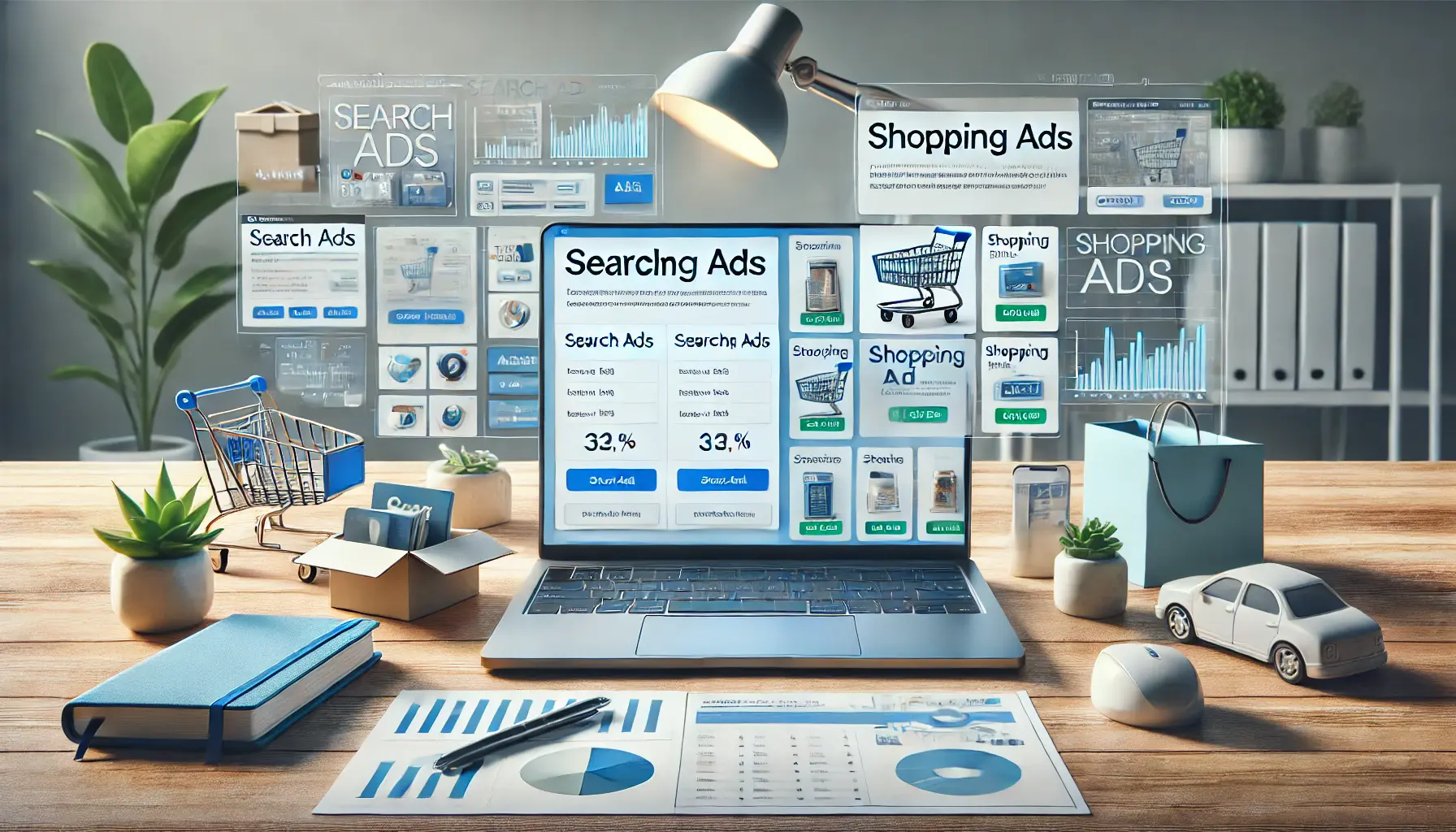
Illustration of the decision-making process between Search Ads and Shopping Ads for e-commerce campaigns.
Choosing the Right Campaign Types: Search vs. Shopping Ads
Google Ads has a variety of campaign types that fit different marketing objectives.
Among them, for a dropshipping business, the most applicable would be:
- Search Campaigns: These are text ads shown on search results once users have queried certain keywords. They’re great for targeting users actively searching for products like yours.
- Shopping Campaigns: These ads showcase product images, prices, and store names directly in search results, providing a visual appeal that can enhance click-through rates. They are particularly beneficial for e-commerce and dropshipping businesses.
Consider your specific goals and resources when choosing between these campaign types.
In many cases, a combination of both can yield optimal results.

Visual representation of creating impactful ad copy and visuals for Google Ads campaigns.
Developing Compelling Ad Copy and Creative
Your ad content plays a crucial role in attracting potential customers.
To craft compelling ads:
- Highlight Unique Selling Propositions (USPs): Clearly communicate what sets your products apart from competitors.
- Include Strong Calls-to-Action (CTAs): Encourage users to take specific actions, such as ‘Shop Now’ or ‘Learn More.’
- Ensure Consistency: Align your ad copy with the content on your landing pages to provide a seamless user experience.
- Use High-Quality Images: For Shopping Ads, utilize clear and attractive product images to capture attention.
Engaging and relevant ad content can significantly improve your ads’ performance, leading to higher click-through and conversion rates.
Illustration of setting up conversion tracking and analytics for optimizing Google Ads campaigns.
Implementing Conversion Tracking and Analytics
To assess the effectiveness of your campaigns and make data-driven decisions:
- Set Up Conversion Tracking: Utilize tools like Google Analytics to track valuable actions such as purchases, sign-ups, and more on your site.
- Analyze Performance Metrics: On a regular basis, review metrics including click-through rates, conversion rates, and return on ad spend to identify areas for improvement.
- Adjust Strategies Accordingly: Based on your analysis, refine your keywords, ad copy, and bidding strategies to enhance performance.
By constantly tracking your campaign data, you can always optimize your Google Ads for sustained success with your dropshipping business.
Effective keyword research and compelling ad copy are fundamental for creating high-performing Google Ads campaigns.
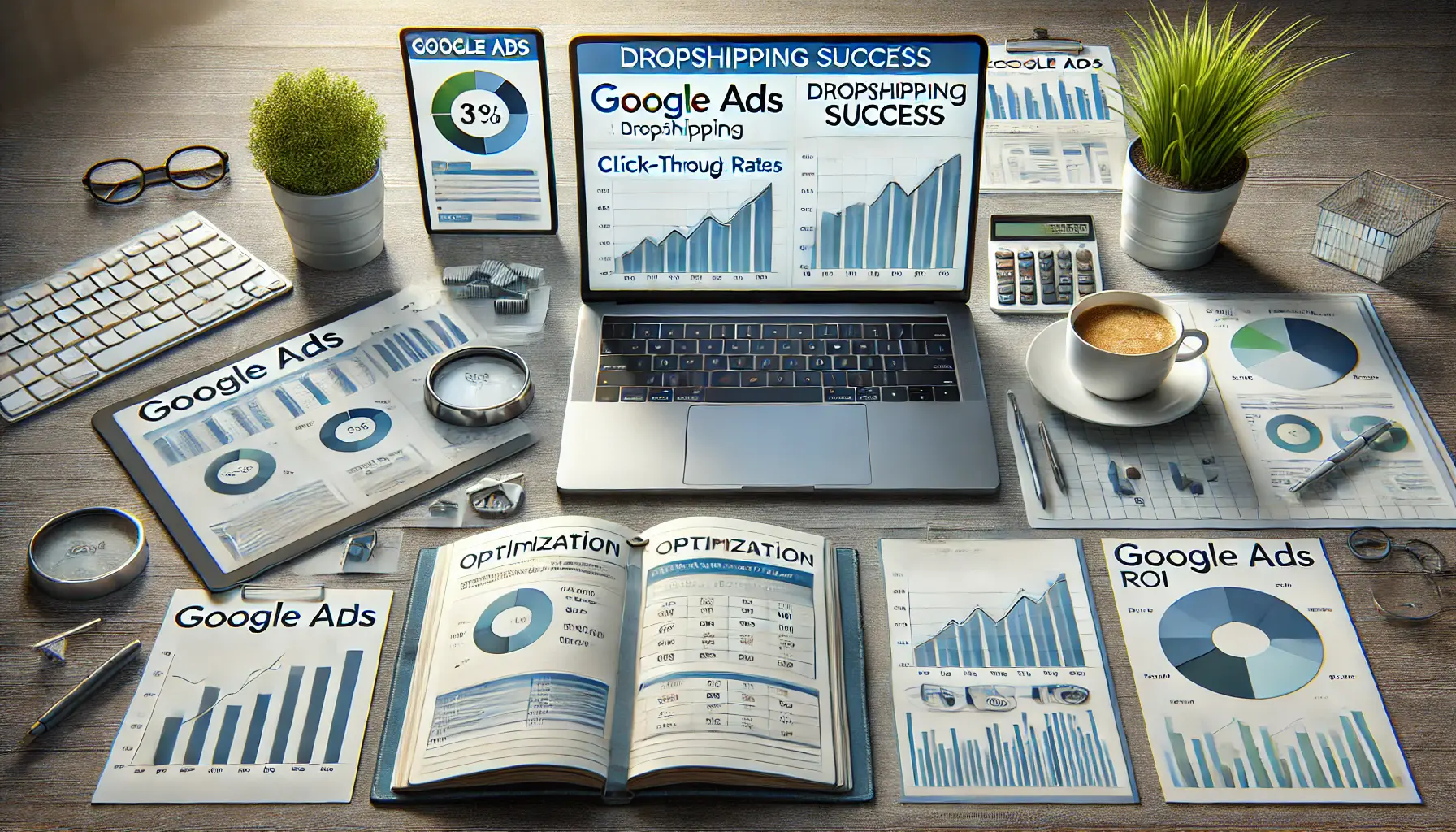
Illustration of the optimization process for Google Ads campaigns tailored for dropshipping success.
Optimizing Google Ads Campaigns for Dropshipping Success
To maximize the effectiveness of your Google Ads campaigns in the dropshipping landscape, it’s essential to implement strategic optimization techniques.
This involves refining your bidding strategies, allocating budgets wisely, and continuously monitoring performance to ensure a high return on investment (ROI).

undefined
Implementing Smart Bidding Strategies
Google Ads offers several bidding strategies that are designed to align with your specific campaign goals.
Choosing the right strategy will help you achieve the desired outcome of your campaign.
For example:
- Maximize Conversions: This automated bidding strategy adjusts your bids to help get the most conversions within your budget, using Google’s machine learning to optimize for conversions in every auction.
- Target CPA (Cost Per Acquisition): Set a target cost you’re willing to pay for each conversion. Google Ads will automatically set bids to achieve as many conversions as possible at or below your target CPA.
- Target ROAS (Return on Ad Spend): Define the desired return on ad spend, and Google Ads will maximize the conversion value to ensure it meets your targeted ROAS.
Choosing the right bidding strategy ensures that your ads are competitive in auctions, helping you reach potential customers effectively while controlling costs.

Illustration of effective budget allocation strategies for Google Ads campaigns.
Allocating Budgets Effectively
Proper budget allocation is vital for sustaining your campaigns and achieving profitability:
- Determine Your Daily Budget: Assess your overall marketing budget and divide it by the number of days in your campaign period to establish a daily budget. Google Ads calculates the budget on a daily basis; to determine the monthly budget, multiply the daily budget by 30.4, the average number of days in a month.
- Employ Shared Budgets: If running several campaigns, utilize shared budgets to dynamically allocate funds across campaigns based on performance and opportunity.
- Monitor and Adjust: Periodically check spending and performance data to reallocate budgets to high-performing campaigns or pause underperforming ones.
Effective budget management ensures that your advertising spend is utilized efficiently, maximizing the impact of your marketing efforts.
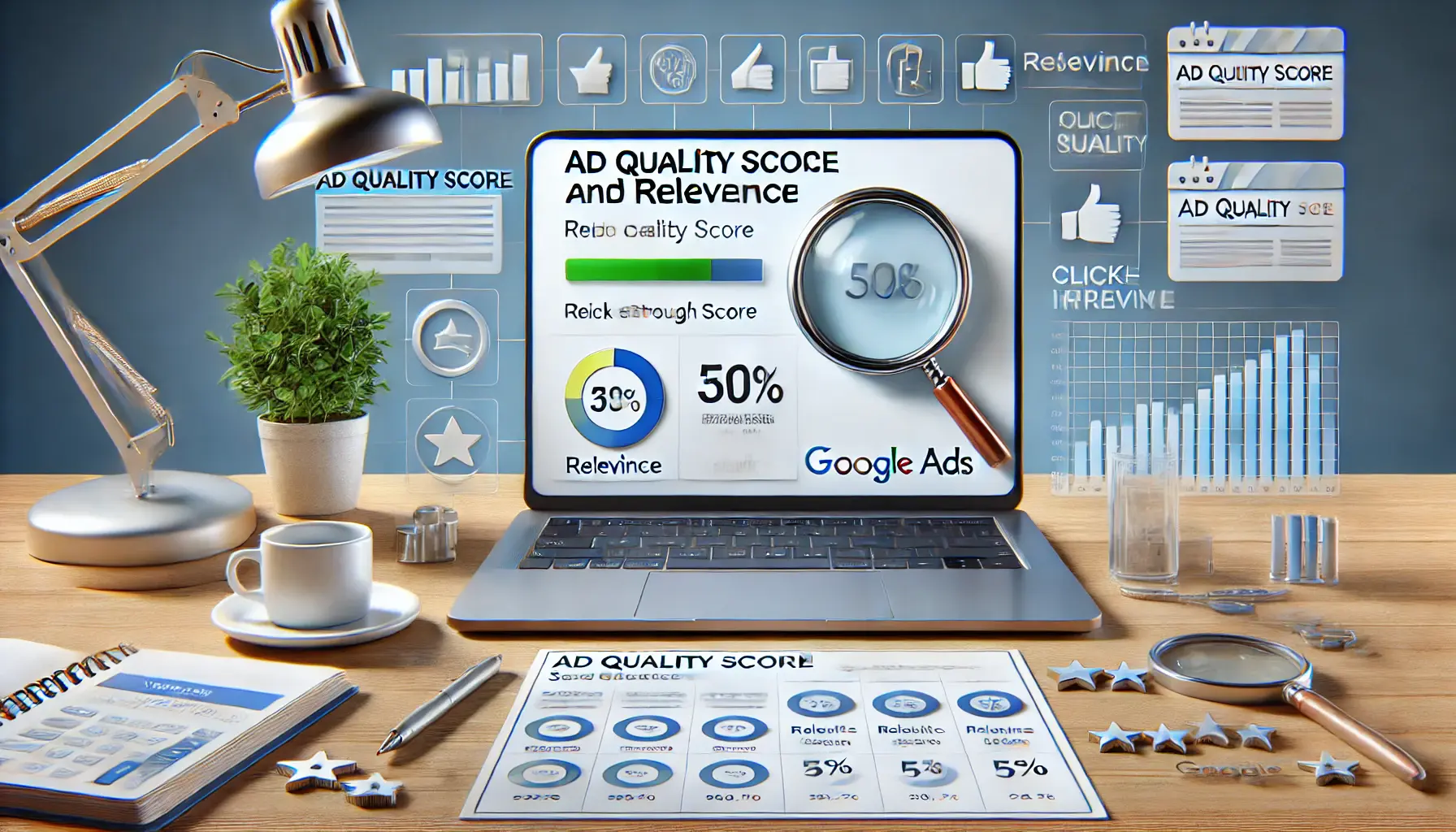
Illustration of strategies to enhance ad quality and relevance in Google Ads campaigns.
Improving Ad Quality and Relevance
The quality and relevance of your ads will directly affect their performance and cost-effectiveness:
- Improve Quality Score: Focus on increasing ad relevance, expected click-through rate, and landing page experience to raise your Quality Score for better ad positions at a lower cost.
- Utilize Ad Extensions: Use ad extensions like site links, callouts, and structured snippets to add more information to your ad and increase visibility.
- Conduct A/B Testing: Regularly test different ad creatives, headlines, and calls-to-action to identify the most effective combinations.
By prioritizing ad quality and relevance, you can improve user engagement and achieve better results from your campaigns.

Illustration of leveraging audience targeting features for Google Ads campaigns.
Leveraging Audience Targeting
Precise audience targeting enhances the efficiency of your ads by reaching users most likely to convert:
- Implement Remarketing Campaigns: Target users who have previously visited your site or interacted with your products, keeping your brand top-of-mind and encouraging return visits.
- Use Custom Intent Audiences: Create audiences based on users’ search behavior and interests, allowing for more personalized ad delivery.
- Apply Demographic Targeting: Adjust your targeting settings to focus on specific demographics such as age, gender, and household income that align with your ideal customer profile.
This effective audience targeting ensures that users most likely to convert see your ads, maximizing your ad spend for a better ROI.
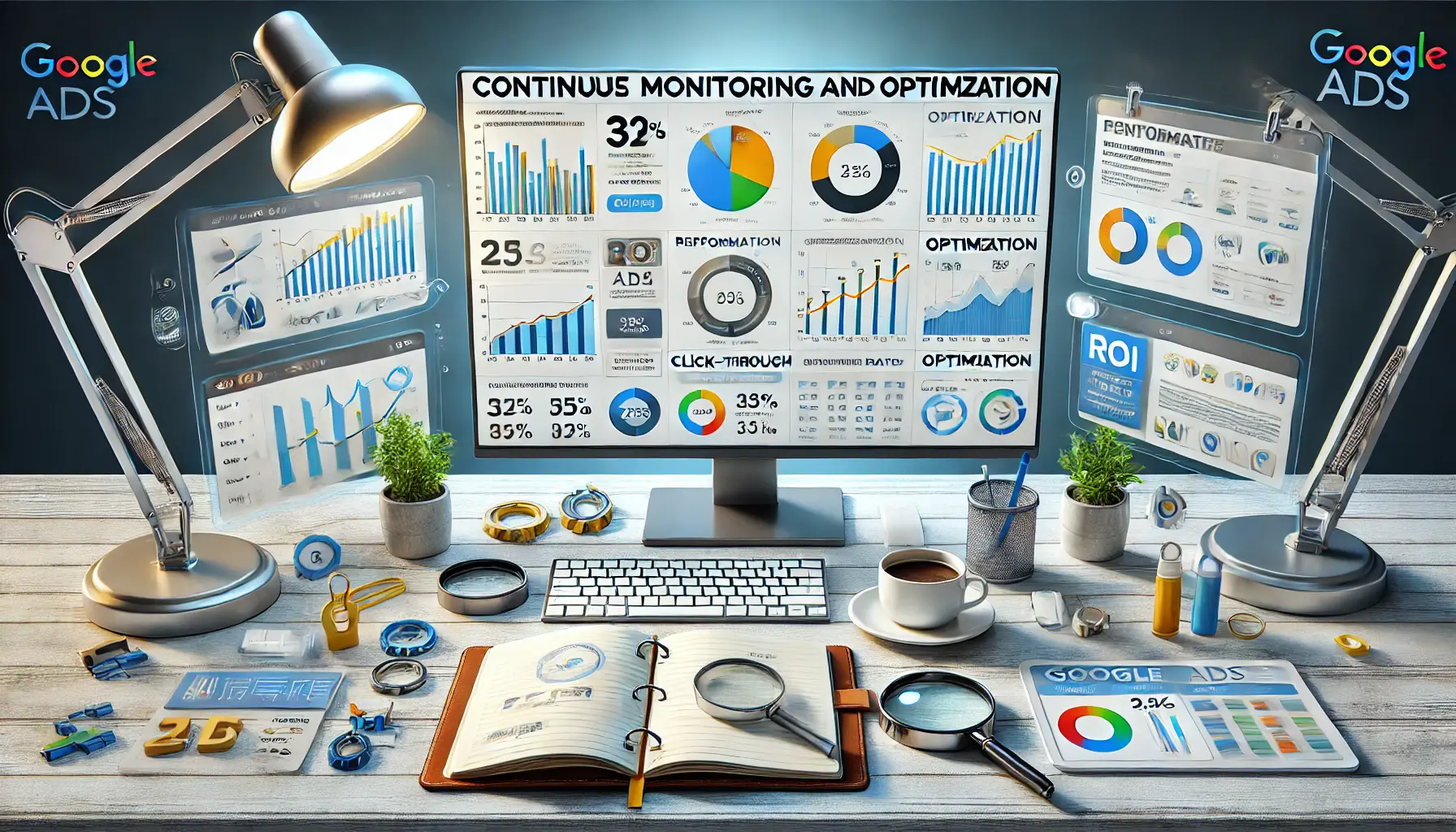
Illustration of continuous monitoring and optimization strategies for Google Ads campaigns.
Continuous Monitoring and Optimization
Ongoing analysis and refinement are key to keeping your Google Ads campaigns successful:
- Regular Performance Reviews: Analyze key metrics such as click-through rates, conversion rates, and cost per conversion to assess campaign effectiveness.
- Adjust Bids and Budgets: Based on performance data, modify bids and reallocate budgets to capitalize on successful strategies and mitigate underperformance.
- Stay Informed on Trends: Keep abreast of industry trends, seasonal fluctuations, and changes in consumer behavior to adapt your campaigns accordingly.
By being proactive with campaign management, you’ll ensure that your Google Ads efforts stay aligned with your business objectives and remain responsive to market dynamics.
Continuous monitoring, smart bidding, and audience targeting are key to optimizing your Google Ads campaigns for better ROI.

Illustration of advanced strategies for using Google Ads in dropshipping campaigns.
Advanced Techniques in Google Ads for Dropshipping
For dropshippers aiming to elevate their Google Ads strategies, delving into advanced techniques can yield significant returns.
These methods involve a deeper understanding of Google Ads’ capabilities and leveraging them for more sophisticated campaigns.

Illustration of using dynamic remarketing to tailor Google Ads campaigns for individual user behavior.
Utilizing Dynamic Remarketing
Dynamic remarketing allows you to show ads featuring the specific products that visitors viewed on your site, creating a highly personalized ad experience.
This approach can significantly increase conversion rates by re-engaging potential customers with tailored content.
- Set Up Dynamic Remarketing Tags: Implement dynamic remarketing tags on your website to track product-specific visitor data.
- Personalize Ads Creatively: Create ads displaying products dynamically that each visitor was interested in for better relevance.
- Segment Your List: Segment based on behavior, such as abandoners or past purchasers, for effective messaging.
By using dynamic remarketingA type of remarketing that shows ads featuring the exact products or services users viewed on a website., you can keep the brand top of mind and drive more return visits to increase sales.

Illustration of leveraging AI-powered tools to optimize and supercharge Google Ads campaigns.
Leverage AI-Powered Tools to Supercharge Your Campaigns
Artificial intelligence is changing how dropshippers manage and optimize Google Ads campaigns.
AI tools can analyze vast amounts of data for actionable insights, automate tasks, and improve decision-making processes.
- Automated Bid Adjustments: Leverage AI to automatically adjust bids based on real-time performance data for optimal ad spend.
- Predictive Analytics: Set up AI-driven predictive analytics to forecast trends and proactively adjust campaigns.
- Ad Creative Generation: Utilize AI to generate and test multiple ad creatives, identifying the most effective combinations.
Integrating AI tools into your advertising strategy can lead to more efficient campaigns and improved ROI.

Illustration of advanced audience segmentation strategies for Google Ads campaigns.
Implementing Advanced Audience Segmentation
Advanced audience segmentation enables you to target specific groups within your broader audience, allowing for more personalized and effective advertising.
- Custom Affinity Audiences: Create audiences from interests and habits that align with your products.
- In-Market Audiences: Target users actively searching for something similar to what you’re offering, indicating higher purchase intent.
- Life Event Targeting: Reach users experiencing specific life events like moving or marriage, which are potential triggers for purchases.

Illustration of exploring and optimizing Google Shopping Ads for e-commerce success.
Exploring Google Shopping Ads
Google Shopping Ads showcase your products directly in search results with images, prices, and store information, providing a visual appeal that can enhance click-through rates.
- Optimize Product Feed: Ensure your product titles, descriptions, and images are accurate and compelling to attract potential customers.
- Set Competitive Pricing: Monitor competitor pricing to position your products attractively within the market.
- Utilize Promotions: Highlight special offers or discounts to entice clicks and conversions.
Effectively managing Google Shopping Ads can lead to increased visibility and sales for your dropshipping business.

Illustration of monitoring and adapting to trends in Google Ads campaigns.
Monitoring and Adapting to Trends
Staying informed about industry trends, seasonal fluctuations, and changes in consumer behavior is crucial for maintaining the effectiveness of your Google Ads campaigns.
- Regular Market Analysis: Conduct ongoing research to identify emerging trends and update your product offerings accordingly.
- Seasonal Campaign Adjustments: Adapt your advertising strategies to seasonal demand and consumer interests.
- Competitor Monitoring: Keep an eye on competitor activities to find opportunities and threats in the market.
If you are proactive and adapt quickly, your advertising efforts will remain relevant and effective in a dynamic market environment.
Advanced strategies like dynamic remarketing and AI-powered tools can significantly boost your dropshipping campaigns’ efficiency and results.

Illustration of key takeaways for mastering Google Ads in dropshipping campaigns.
Key Takeaways for Mastering Google Ads in Dropshipping
Successfully managing Google Ads for your dropshipping business requires a combination of foundational knowledge, strategic planning, and continuous optimization.
Each section of this article has highlighted the critical elements necessary to achieve success and maximize your return on investment.

undefined
Building a Strong Foundation
The journey begins with setting up your Google Ads account correctly.
From linking your Google Merchant Center to defining clear campaign objectives, these initial steps create a solid framework for effective advertising.
Ensure your account is properly configured to align with your business goals and target audience.

Illustration of crafting and refining Google Ads campaigns for dropshipping success.
Crafting and Refining Campaigns
Creating high-performing campaigns involves meticulous keyword research, selecting the right campaign types, and developing compelling ad content.
Leveraging tools like Google’s Keyword Planner and experimenting with Search and Shopping Ads enables you to tailor your approach to your audience’s needs.
By continuously refining your ad copy and visuals, you can maintain a competitive edge.

Illustration of optimizing Google Ads campaigns for better performance and results.
Optimizing for Better Results
Optimization is the key to long-term success.
Smart bidding strategies, effective budget allocation, and improving ad relevance ensure your campaigns remain cost-efficient and impactful.
Regular monitoring and testing allow you to identify what works and adjust accordingly to maximize ROI.

Illustration of exploring advanced strategies for optimizing Google Ads campaigns.
Exploring Advanced Strategies
Advanced techniques such as dynamic remarketing, AI-powered tools, and audience segmentation take your campaigns to the next level.
These strategies help you connect with potential customers on a more personal level while optimizing your ad spend.
Additionally, utilizing Google Shopping Ads and staying updated with market trends ensures your dropshipping business remains competitive in an ever-evolving landscape.

Illustration of looking ahead and planning for future opportunities in Google Ads and dropshipping.
Looking Ahead
To be successful in dropshipping with Google Ads, consistency and adaptability are essential.
As you implement and optimize the strategies discussed in this guide, remember that digital marketing is highly dynamic.
Staying informed and proactive will enable you to use Google Ads as a powerful tool in driving growth and profitability in your dropshipping business.
By applying the techniques covered in this article, you are well-equipped to navigate the complexities of Google Ads and elevate your dropshipping venture to new heights.
Building a strong foundation and continuously optimizing campaigns are critical steps toward success in dropshipping with Google Ads.
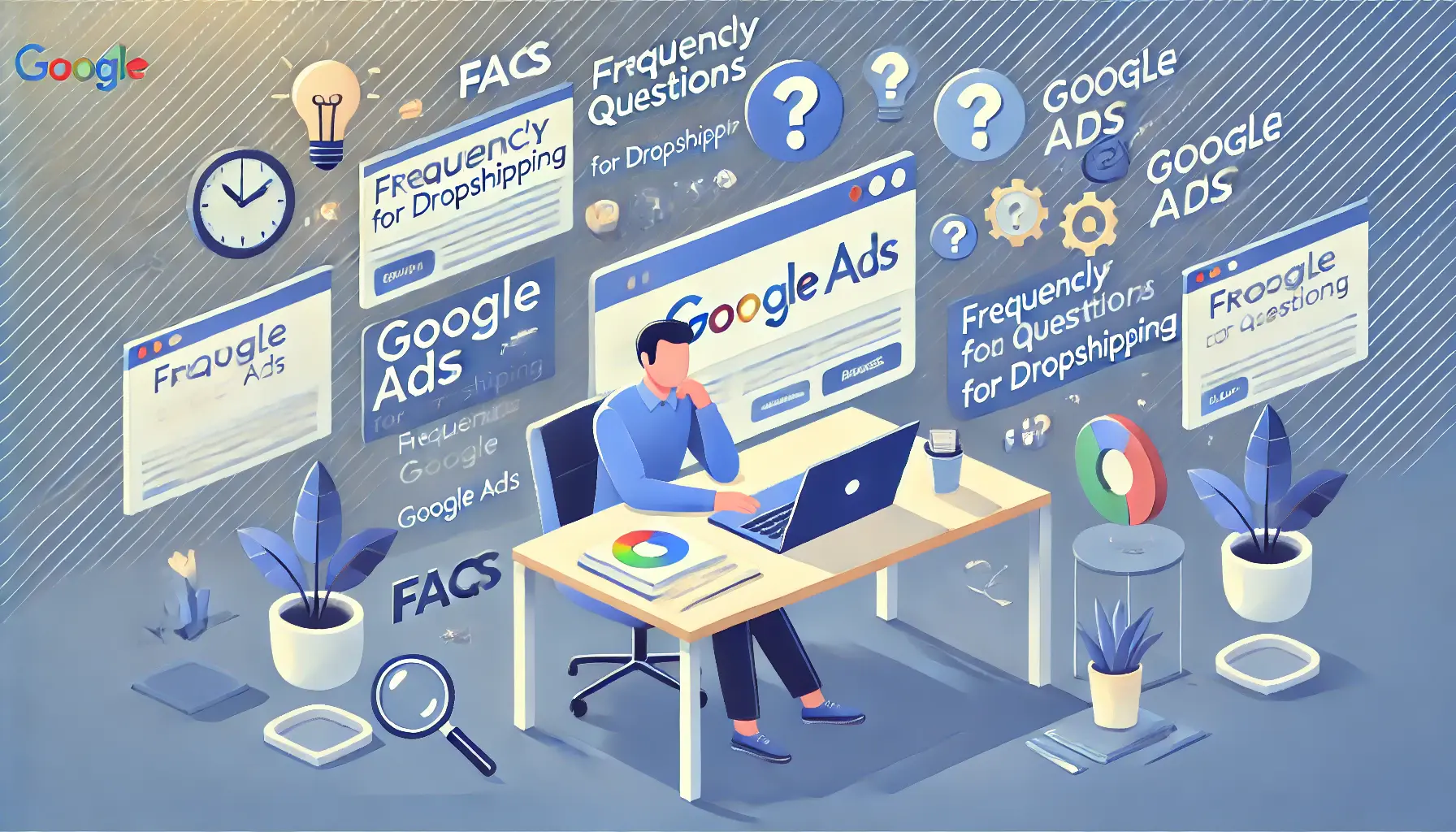
Illustration of frequently asked questions related to Google Ads for dropshipping, emphasizing curiosity and problem-solving.
Your campaigns can be managed by an agency specialized in Google Ads, check out our service page.
Frequently Asked Questions About Google Ads for Dropshipping
Answering some of the most common questions will help provide a better understanding of how to use Google Ads in dropshipping.
Yes, Google Ads can significantly boost visibility and sales for dropshipping stores since ads appear when users search for related products.
Search and Shopping campaigns are particularly effective, allowing you to showcase products directly in search results and attract high-intent buyers.
Start with a modest daily budget, monitor performance closely, and adjust based on which campaigns yield the highest return on investment.
Focus on click-through rates, conversion rates, cost per conversion, and return on ad spend to evaluate and optimize campaign performance.
Enhance ad relevance, optimize landing pages for better user experience, and ensure keywords align closely with your ad content.
Automated bidding strategies like Target CPAA bidding strategy in Google Ads that aims to get as many conversions as possible at or below a specified cost per acquisition. can optimize bids in real-time, but manual bidding offers more control; choose based on your campaign goals and expertise.
Thorough keyword research is crucial; it ensures your ads appear for relevant searches, maximizing the chances of reaching potential customers.
No, a functional website is necessary to direct traffic from your ads and provide a platform for transactions.
Utilize Google Analytics to track user behavior, conversions, and other key performance indicators to assess and refine your campaigns.










